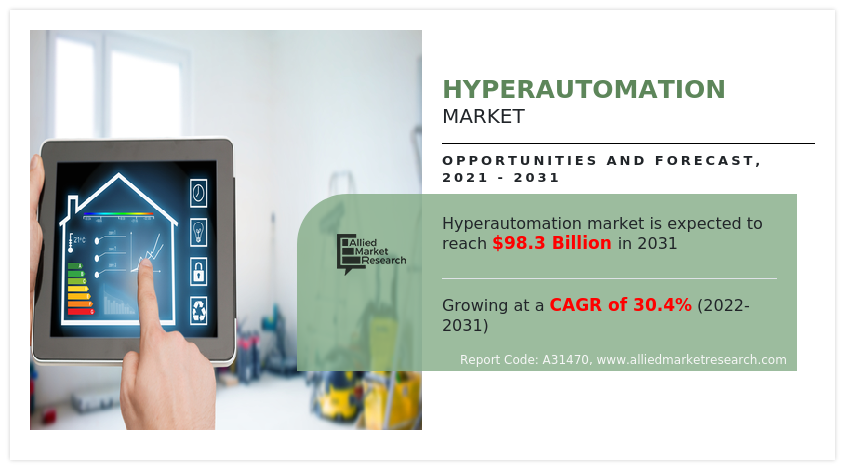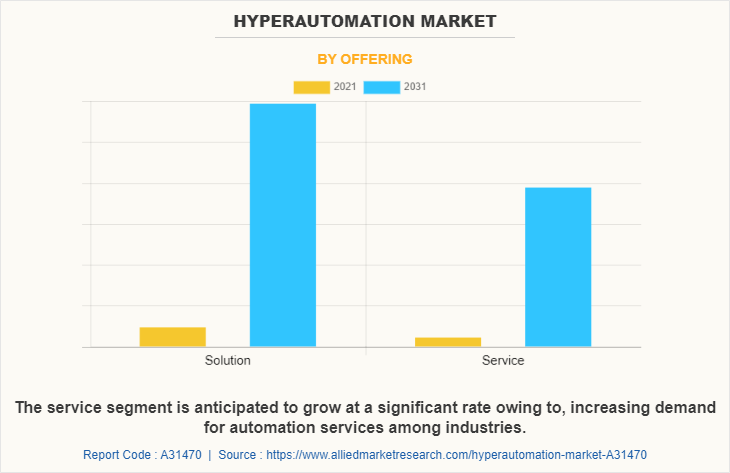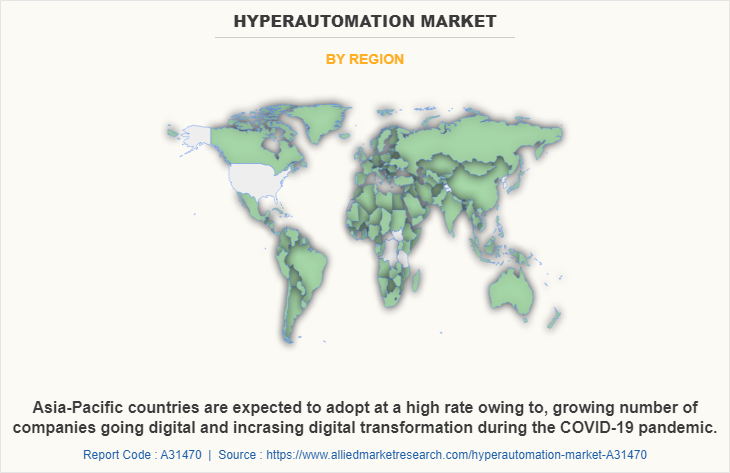Hyperautomation Market Insights, 2031
The global hyperautomation market size was valued at USD 6.9 billion in 2021, and is projected to reach USD 98.3 billion by 2031, growing at a CAGR of 30.4% from 2022 to 2031.
Digitalization of the traditional manufacturing plants and increased adoption of automated manufacturing processes by various industries drive the growth of the hyperautomation market. In addition, high growth of digital transformation with advanced techniques in hyperautomation fuels the growth of the market. However, lack of skilled manpower and trainers in hyperautomation and high initial cost of automation system are expected to impede the hyperautomation market growth. Furthermore, increase in demand for automation among major industries is expected to provide lucrative opportunities for the market growth.

Hyperautomation market deals with the application of advanced technologies to automate processes and augment human activity. In addition, it is based on the range of tools that can be automated and it also refers to sophisticated level of the automation i.e., analysis, design, discover, measure, monitor, automate, and re-assess. In addition to this, this technology provides a high-speed route in transforming the business, supported by automating highly complex process that relies on knowledge inputs from people. The hyperautomation market is segmented into Enterprise Size, Application, Industry Vertical, Offering and Deployment Mode.
Segment Review
The global hyperautomation market is segmented based on offering, deployment mode, enterprise size, application, industrial vertical, and region By offering, it is divided into solution and service. By deployment mode, it is classified into on-premise and cloud. By enterprise size, it is divided into large enterprise size and SMEs. By application, it is fragmented into, supply chain, sales and marketing, finance, human resources (HR) and others. In terms of industrial vertical, the market is classified into BFSI, IT and telecom, healthcare, manufacturing, retail and consumer goods, transportation and logistics and others. By geography, it is analyzed across North America, Europe, Asia-Pacific, and LAMEA.
The major players operating in the hyperautomation market are Appian, Automation Anywhere, ALLERIN TECH PVT LTD, Catalytic, Celonis, Decisions, ElectroNeek Robotics Inc, G1ANT, Laiye, OneGlobe LLC, Infosys Limited, SolveXia, Tata Consultancy services, Microsoft Corporation, IBM Corporation, ProcessMaker and Automate.io. These players have adopted various strategies to increase their market penetration and strengthen their position in the industry.
In terms of offering, the solution segment holds the largest hyperautomation market share in the forecast period, owing to increased demand of operational efficiency of the entire industrial network even with low infrastructure investment. However, the service segment is expected to grow at the highest rate during the forecast period, owing to rapid urbanization and rapid adoption of advanced technologies for innovating smart services, which influence solutions in the hyperautomation market.

Region wise, the hyperautomation market share was dominated by North America in 2021 and is expected to retain its position during the forecast period, owing to the presence of major players that offer advanced solutions and invest heavily in solutions such as AI, IoT technologies and robotic automation which offers lucrative opportunity for the market. However, Asia-Pacific is expected to witness significant growth during the forecast period, due to presence and ongoing expansion of robotics and factory automation products and manufacturing companies.

Top Impacting Factors
Digitalization of the traditional manufacturing plants
Digitization is the process of converting data or information into a digital format with the adoption of advance technology. It plays very important role in the manufacturing plant owing to growing need among the manufacturing providers for providing enhanced customer services and to improve the security of the customer. Digital technologies for traditional manufacturing plants include additive manufacturing, robotic automation, hyperautomation and predictive automation it helps to predicts impending breakdowns and mitigates downtime in manufacturing activities. Furthermore, around 76% manufacturers use automation to improve factory floor’s productivity as a key strategy for increasing growth.
In addition, digitalization is in high demand for traditional manufacturing plants as more the money, more work is required to maintain and preserve those assets. These individuals generally demand personalized services in inventory movements, WIP manufacturing costs, and operation progress, and so on. Such demands are driving the growth of the hyperautomation industry.
Increased adoption of automated manufacturing processes by various industries
Automated manufacturing process is an ever-evolving industry, and opportunities emerge regularly. In addition, several manufacturing industries are implementing hyperautomation to reduce operating expenditure, and improves the overall efficiency of the manufacturing process. Moreover, some companies in the manufacturing sectors are implementing innovative business practices that maintain cost savings and streamline operations throughout the supply chain more quickly.
For instance, in September 2021, GEA has launched Batch2Flow, a solution that secures the food production process, saves energy and water and significantly reduces the use of cleaning chemicals. Therefore, manufacturing companies are enabling automated manufacturing processes to have a secure payment process and purchasing, inventory management and customer communication, which in turn is driving the growth of the hyperautomation industry.
COVID-19 Impact Analysis
The hyperautomation market has recorded continuous investments for its developments and has become a massive contributor to the economic growth. However, the COVID-19 pandemic has substantially impacted the value chain of the hyperautomation market. In addition, resulting in decreased shipments of component and solution of Hyperautomation and the revenues generated from them. Furthermore, COVID-19 pandemic has impacted almost all the industries globally including Hyperautomation and machinery. Moreover, as a result, a drop was witnessed in the growth trend of the market during the first half of 2020. This is expected to discontinue in the latter half of the year as the demand is expected to increase due to the growing concern for smart automation, energy and resource efficiency.
Key Benefits For Stakeholders
- This report provides a quantitative analysis of the Hyperautomation Market Forecast, current trends, estimations, and dynamics of the hyperautomation market analysis from 2021 to 2031 to identify the prevailing hyperautomation market opportunities.
- The market research is offered along with information related to key drivers, restraints, and opportunities.
- Porter's five forces analysis highlights the potency of buyers and suppliers to enable stakeholders make profit-oriented business decisions and strengthen their supplier-buyer network.
- In-depth analysis of the hyperautomation market segmentation assists to determine the prevailing market opportunities.
- Major countries in each region are mapped according to their revenue contribution to the global market.
- Market player positioning facilitates benchmarking and provides a clear understanding of the present position of the market players.
- The report includes the analysis of the regional as well as global hyperautomation market trends, key players, market segments, application areas, and market growth strategies.
Hyperautomation Market Report Highlights
| Aspects | Details |
| Market Size By 2031 | USD 98.3 billion |
| Growth Rate | CAGR of 30.4% |
| Forecast period | 2021 - 2031 |
| Report Pages | 335 |
| By Enterprise Size |
|
| By Application |
|
| By Industry Vertical |
|
| By Offering |
|
| By Deployment Mode |
|
| By Region |
|
| Key Market Players | TATA CONSULTANCY SERVICES, CATALYTIC, G1ANT, INFOSYS LIMITED, ELECTRONEEK ROBOTICS INC, MICROSOFT CORPORATION, IBM CORPORATION, ALLERIN TECH PVT LTD., AUTOMATION ANYWHERE, INC., ONEGLOBE, LLC, LAIYE, APPIAN, CELONIS, DECISIONS., SOLVEXIA |
Analyst Review
Hyper Automation is the improvement of traditional automation capabilities via the use of robotic process automation (RPA) and other technologies such as artificial intelligence (AI), machine learning (ML), and others for automated operations. In addition, this technology is expected to have the greatest acceptance in the banking, financial services, and insurance (BFSI) sectors, as the majority of the BFSI sector currently uses RPA, which is expected to be replaced by hyper automation. Furthermore, the automotive industry is rapidly adopting hyper automation solutions to confirm whether components require a warranty or replacement, which in turn is expected to boost the market growth. RPA is the primary instrument in the hyper automation sector, which is being taken to an advanced level through the application of artificial intelligence, analytics, and other technologies.
The global hyper automation market is expected to register high growth due to worldwide digitization and automation of manufacturing processes, such as easy accessibility and forced to face new hurdles as a result of technological improvements demand for hyper automation in end user industries are anticipated to contribute toward the growth of the global hyper automation market. With growth in requirement for hyper automation, various companies have established alliance to increase their capabilities. For instance, in July 2022, Automation Anywhere partnered with Rayan to arm tax professionals with robotic process automation (RPA) to refine operational efficiencies. For instance, in March 2022 Celonis partnered with IBM, to scale the adoption of process mining and execution management in the Asia-Pacific (APAC) region. This partnership helps to provide cloud-based solutions to support customers in the APAC region.
In addition, with further growth in investment across the world, the rise in demand for hyper automation, various companies have expanded their current product portfolio with increased diversification among customers. For instance, in August 2021, ElectroNeek Robotics Inc launched new ElectroNeek Summer 21 product release available, new capabilities for ElectroNeek Studio Pro, Orchestrator, and Bot Runner. the new features that further enhance offerings and support broader administration and management capabilities for the Managed Service Providers and IT teams.
Moreover, considering the impact of rising competition, major market players have started acquisition and partnership with other companies to expand their market penetration and reach globally. For instance, in March 2022, Accenture acquired Trancom ITS to enable Accenture’s Industry X service to offer hyper-automation solutions. This will help increase its demand among the manufacturing and logistics companies in Japan to become more efficient and sustainable in their core operations.
The global hyperautomation market was valued at $6.85 billion in 2021, and is projected to reach $98.26 billion by 2031.
The global hyperautomation market is projected to grow at a compound annual growth rate of 30.4% from 2021-2030 to reach USD 98.3 Billion by 2031
The major players operating in the hyperautomation market are Appian, Automation Anywhere, ALLERIN TECH PVT LTD, Catalytic, Celonis, Decisions, ElectroNeek Robotics Inc, G1ANT, Laiye, OneGlobe LLC, Infosys Limited, SolveXia, Tata Consultancy services, Microsoft Corporation, IBM Corporation, ProcessMaker and Automate.io.
Region-wise, the hyperautomation market share was dominated by North America in 2021.
The growth of the hyperautomation market is driven by the digitalization of traditional manufacturing and the rising adoption of automated processes across industries, along with rapid advancements in digital transformation technologies.
Loading Table Of Content...



